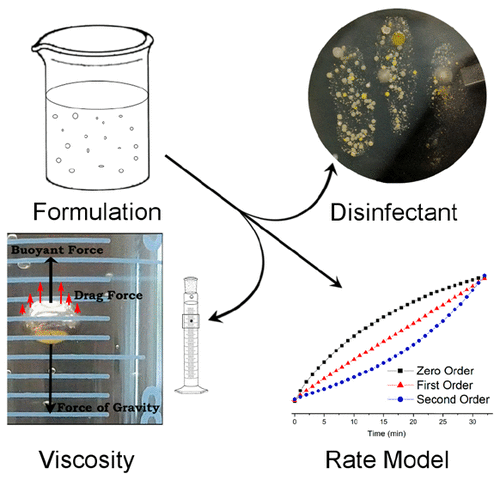当前位置:
X-MOL 学术
›
J. Chem. Educ.
›
论文详情
Our official English website, www.x-mol.net, welcomes your feedback! (Note: you will need to create a separate account there.)
Expanding Evaporation Rate Model Determination of Hand-Rub Sanitizers to the General Freshman and Engineering Chemistry Undergraduate Laboratory: Inquiry-Based Formulations, Viscosity Measurements, and Qualitative Biological Evaluations
Journal of Chemical Education ( IF 3 ) Pub Date : 2018-05-25 00:00:00 , DOI: 10.1021/acs.jchemed.7b00969 Daniel E. Felton 1 , James G. Moberly 2 , Martina M. Ederer 3 , Patricia L. Hartzell 3 , Kristopher V. Waynant 1
Journal of Chemical Education ( IF 3 ) Pub Date : 2018-05-25 00:00:00 , DOI: 10.1021/acs.jchemed.7b00969 Daniel E. Felton 1 , James G. Moberly 2 , Martina M. Ederer 3 , Patricia L. Hartzell 3 , Kristopher V. Waynant 1
Affiliation

|
Additions to the popular evaporation rate determination laboratory of alcohol-based hand-rub sanitizers are described here. Significantly, inquiry-driven protocols for formulating hand-rub sanitizers, falling-ball viscometry, and sanitizer efficacy are included. Incorporation of familiar substances (“molecular relevance”) enables students to assimilate knowledge and connect to and recognize interrelated disciplines. To stimulate engagement and project ownership, students were given the opportunity to alter sanitizer formulations by varying the amount and molecular weight of the gelling agent. Viscosities were determined using a falling-ball viscometer to integrate physics and fluid dynamics concepts into these experiments. Lastly, to stress microbiological applications and determine the efficacy of their hand sanitizers, students tested the formulated hand sanitizers for qualitative efficacy using agar plating of skin secretions and comparing colonies formed from sanitized versus nonsanitized hands. Chemistry students with diverse interests recognized links across disciplinary boundaries (e.g., increased their awareness of physical properties of hand sanitizers and the relationship of molecular-scale phenomena to these properties). This three-hour laboratory provides an interdisciplinary supplement directly designed for freshman chemistry and engineering chemistry undergraduates and increases integration among biology, chemistry, engineering, and physics.
中文翻译:

将手擦消毒剂的蒸发速率模型确定扩展到普通新生和工程化学本科实验室:基于询问的配方,粘度测量和定性生物学评估
在此介绍了流行的酒精基手揉搓洗手液蒸发速率测定实验室的内容。重要的是,还包括了由查询驱动的用于配制手揉搓洗手液,落球粘度计和洗手液功效的协议。掺入熟悉的物质(“分子相关性”)使学生能够吸收知识并与相互关联的学科建立联系并予以认可。为了激发参与度和项目所有权,学生有机会通过改变胶凝剂的量和分子量来改变消毒剂的配方。使用落球粘度计将物理和流体动力学概念整合到这些实验中来确定粘度。最后,为了强调微生物应用并确定其洗手液的功效,学生们使用琼脂平板皮肤分泌物测试了配制的洗手液的定性功效,并比较了经过消毒和未经消毒的手形成的菌落。兴趣各异的化学专业学生认识到跨学科界限的联系(例如,提高了对洗手液物理特性的认识,以及分子尺度现象与这些特性之间的关系)。这个三小时的实验室提供了跨学科的补充课程,直接为新生化学和工程化学专业的本科生设计,并增加了生物学,化学,工程学和物理学之间的整合。兴趣各异的化学专业学生认识到跨学科界限的联系(例如,提高了对洗手液物理特性的认识,以及分子尺度现象与这些特性之间的关系)。这个三小时的实验室提供了跨学科的补充课程,直接为新生化学和工程化学本科生设计,并增加了生物学,化学,工程学和物理学之间的整合。兴趣各异的化学专业学生认识到跨学科界限的联系(例如,提高了对洗手液物理特性的认识,以及分子尺度现象与这些特性之间的关系)。这个三小时的实验室提供了跨学科的补充课程,直接为新生化学和工程化学专业的本科生设计,并增加了生物学,化学,工程学和物理学之间的整合。
更新日期:2018-05-25
中文翻译:

将手擦消毒剂的蒸发速率模型确定扩展到普通新生和工程化学本科实验室:基于询问的配方,粘度测量和定性生物学评估
在此介绍了流行的酒精基手揉搓洗手液蒸发速率测定实验室的内容。重要的是,还包括了由查询驱动的用于配制手揉搓洗手液,落球粘度计和洗手液功效的协议。掺入熟悉的物质(“分子相关性”)使学生能够吸收知识并与相互关联的学科建立联系并予以认可。为了激发参与度和项目所有权,学生有机会通过改变胶凝剂的量和分子量来改变消毒剂的配方。使用落球粘度计将物理和流体动力学概念整合到这些实验中来确定粘度。最后,为了强调微生物应用并确定其洗手液的功效,学生们使用琼脂平板皮肤分泌物测试了配制的洗手液的定性功效,并比较了经过消毒和未经消毒的手形成的菌落。兴趣各异的化学专业学生认识到跨学科界限的联系(例如,提高了对洗手液物理特性的认识,以及分子尺度现象与这些特性之间的关系)。这个三小时的实验室提供了跨学科的补充课程,直接为新生化学和工程化学专业的本科生设计,并增加了生物学,化学,工程学和物理学之间的整合。兴趣各异的化学专业学生认识到跨学科界限的联系(例如,提高了对洗手液物理特性的认识,以及分子尺度现象与这些特性之间的关系)。这个三小时的实验室提供了跨学科的补充课程,直接为新生化学和工程化学本科生设计,并增加了生物学,化学,工程学和物理学之间的整合。兴趣各异的化学专业学生认识到跨学科界限的联系(例如,提高了对洗手液物理特性的认识,以及分子尺度现象与这些特性之间的关系)。这个三小时的实验室提供了跨学科的补充课程,直接为新生化学和工程化学专业的本科生设计,并增加了生物学,化学,工程学和物理学之间的整合。



























 京公网安备 11010802027423号
京公网安备 11010802027423号